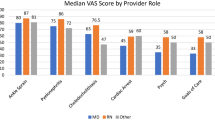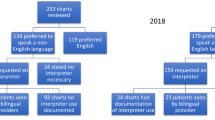Abstract
Objective Identify characteristics of hospital-based language services (LS), and describe practices of identifying patients with limited English proficiency (LEP) and interpreter training. Participants Seventy-one hospitals applied to participate in a national initiative. Applicants were non-federal, acute care hospitals with substantial LEP populations, at least 10,000 discharges, and in-person interpreters. Methods Descriptive statistics were generated on language, collection of language data, LEP volume and service utilization, staffing and training requirements and organizational structure. The relationship between admissions and encounters was analyzed. Results Ninety percent of hospitals collect primary language data. Spanish is the most common language (93% of hospitals). We found no statistically significant correlation between admissions and encounters. Eighty-four percent require training. Eighty-nine percent have a designated LS department but no clear organizational home. Conclusions Hospital-based LS programs are facing challenges identifying patients with language needs, staffing and training a workforce, and creating an organizational identity. Need is not associated with utilization, suggesting that LS are not reaching patients.

Similar content being viewed by others
References
Flores G. Language barriers to health care in the United States. N Engl J Med. 2006;355:229–31.
Flores G, Laws MB, Mayo SJ, Zuckerman B, Abreu M, Medina L, et al. Errors in medical interpretation and their potential clinical consequences in pediatric encounters. Pediatrics. 2003;111:6–14.
Siejo R, Gomez H, Friendenberg J. Language as a communication barrier in medical care for hispanic patients. In: Padilla AM, editor. Hispanic psychology–critical issues in theory and research. California: Sage Publications; 1995. p. 169–81.
Wurthlin Worldwide. Hablamos Juntos: we speak together, 2001. www.hablamosjuntos.org.
Ku L. How race/ethnicity, immigration status and language affect health insurance coverage, access to care and quality of care among the low-income population. District of Columbia: Kaiser Family Foundation; 2003.
Flores G. The impact of medical interpreter services on the quality of health care: a systematic review. Med Care Res Rev. 2005;62:255–99.
Smedley BD, Stith AY, Nelson AR. Unequal treatment: confronting racial and ethnic health disparities. District of Columbia: National Academy Press; 2004.
Baker DW, Parker RM, Williams MV, Coates WC, Pitkin K. Use and effectiveness of interpreters in an emergency department. JAMA. 1996;275:783–8.
Andrulis D, Goodman N, Pryor N. What a difference an interpreter can make: health care experiences of uninsured with limited English proficiency. Massachusetts: The Access Project; 2003.
David RA, Rhee M. The impact of language as a barrier to effective health care in an underserved urban Hispanic community. Mt Sinai J Med. 1998;65:393–7.
Kuo D, Fagan MJ. Satisfaction with methods of Spanish interpretation in an ambulatory care clinic. J Gen Intern Med. 1999;14:547–50.
Lee LJ, Batal HA, Maselli JH, et al. Effect of Spanish interpretation method on patient satisfaction in an urban walk-in clinic. J Gen Intern Med. 2002;17:641–5.
Kashiwagi S. A functional manual for providing linguistically competent health care services as developed by a community health center. California: Asian Pacific Health Care Venture, Inc; 2004.
Paez K, Gunter M, Brach C. Planning culturally and linguistically appropriate services: a guide for managed care plans. Maryland: Centers for Medicare & Medicaid Services; 2004.
Office of Minority Health, Department of Health and Human Services. Health care professionals’ perspectives on the content and structure of the draft health care language services implementation guide (HC-LSIG). Developed by the American Institutes for Research. Maryland: Office of Minority Health; 2005.
Downing B, Roat C. Models for the provision of language access in health care settings. California: National Council on Interpreting in Health Care and Hablamos Juntos; 2002.
Office of Minority Health, Department of Health and Human Services. A patient-centered guide to implementing language access services in healthcare organizations. Prepared by American Institutes of Research. Maryland: Office of Minority Health; 2005.
42 U.S.C. Sec. 2000d-4a; United States Department of Justice’s Policy Guidance on the Enforcement of Title VI, dated August 11, 2000, 65 Fed. Reg. 52762-52774, dated August 30, 2000.
Massachusetts Department of Public Health, Office of Minority Health. Best practice recommendations for hospital-based interpreter services. Massachusetts: Office of Minority Health; undated.
The Robert Wood Johnson Foundation. Speaking together: national language services network, 2006 call for proposals. New Jersey: The Robert Wood Johnson Foundation; 2006.
Langley G, Nolan K, Nolan T, Norman C, Provost L. The improvement guide: a practical approach to enhancing organizational performance. California: Jossey-Bass; 1996.
American Hospital Association. 2005 Annual survey of members. Illinois: American Hospital Association; 2006.
Stata Corp. Stata statistical software: release 9.0. College Station, TX: Stata Corporation; 2005.
U.S. Census Bureau. Census regions: cartographic boundary files descriptions and metadata [Webpage]. District of Columbia: U.S. Census Bureau. Accessed September 28, 2006, from http://www.census.gov/geo/www/cob/rg_metadata.html.
Hasnain-Wynia R, Pittman M. Who, when and how the current state of race, ethnicity and primary language data collection in US hospitals. New York: The Commonwealth Fund; 2004.
Regenstein M, Sickler D. Race, ethnicity and language of patients: hospital practices regarding collection of information to address disparities in health care. District of Columbia: National Public Health and Hospital Institute; 2006.
Regenstein M, Huang J, West C, Mead H, Trott J, Stegun M. Hospital language services: quality improvement and performance measures. Advances in patient safety: new directions and alternative approaches. Rockville, MD: Agency for Healthcare Research and Quality; 2008 (in press).
Regenstein M. Measuring and improving the quality of hospital language services insights from the speaking together collaborative. J Gen Intern Med. 2007;22(Suppl 2):356–9.
Acknowledgments
Support for the study comes from The Robert Wood Johnson Foundation. The views expressed here are those of the authors and should not be attributed to the Robert Wood Johnson Foundation or its directors, officers, or staff.
Author information
Authors and Affiliations
Corresponding author
Rights and permissions
About this article
Cite this article
Regenstein, M., Mead, H., Muessig, K.E. et al. Challenges in Language Services: Identifying and Responding to Patients’ Needs. J Immigrant Minority Health 11, 476–481 (2009). https://doi.org/10.1007/s10903-008-9157-z
Received:
Accepted:
Published:
Issue Date:
DOI: https://doi.org/10.1007/s10903-008-9157-z




